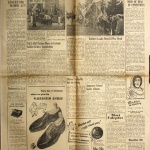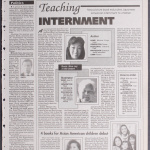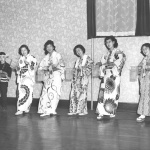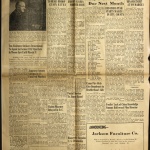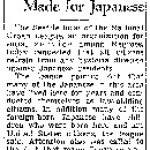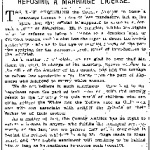Tradition (book)
| Title | Tradition |
|---|---|
| Author | Anne Emery |
| Illustrator | Ruth King |
| Original Publisher | The Vanguard Press |
| Original Publication Date | 1946 |
| Pages | 250 |
Young adult novel about the impact of a family of Japanese American resettlers on a Chicago area community and high school. The first novel by prolific author Anne Emery (1907–84), Tradition was published in 1946 by The Vanguard Press.
Tradition is set in Northridge, a small town near Chicago in the fall of 1944. As the novel begins, protagonist Stacey Kennedy is a popular senior at Northridge High School with a close family that includes an older brother, Thorne, who is in the U.S. military serving in Burma. A Japanese American family, the Okamotos, move into the dilapidated house next door to the Kennedys, and Dorothy and Charlie Okamoto, both seniors, enter Northridge High. Their older brother Bill is also an American GI in Burma. The presence of the Okamotos soon leads to a drive to force them out of town, led by a prominent local businessman and father of one of Stacey's classmates. Despite being outstanding students and an outstanding violinist and basketball player respectively, Dorothy and Charlie face various racist acts at school and later learn that Bill has been killed in action. Though initially unsure about her new neighbors, Stacey and her family come to be their advocates, despite the fact that the boy she has a crush on holds anti-Japanese attitudes. Stacey and her friends ultimately succeed in changing the minds of the school and the town towards the Okamotos, with a strong assist from Thorne, who returns from the Pacific having had his life saved by Bill Okamoto.
Though the novel doesn't go into great detail about the concentration camps, it is made clear that the Okamotos had been in Oregon prior to the war, where Dorothy and Charlie were freshmen when the war broke out. (It is never stated whether or not they are twins.) After being in a "relocation center," their father was able to leave the camp to open a dental practice in Chicago. The family made their home in Northridge due to a housing shortage in Chicago.
Author Anne Emery was born in Fargo, North Dakota, but was raised in Evanston, Illinois, from age nine, graduating from high school there and going on to Northwestern University. She became a public school teacher in Evanston from 1929 to 1939, quitting to raise her own five children. Inspired by the impact books had had on her as a young person, she began to write books aimed at girls aged 10 to 14, beginning her writing career with short stories that ran in her church magazine. Tradition was the first of her 24 books, most of which center on issues faced by girls and young women in high school and college. Her most popular titles include Going Steady (1950), Sweet Sixteen (1956), and The Popular Crowd (1961). [1] She came to know several Nisei who had resettled in Chicago , two of whom worked for her (she doesn't say in what capacity), and wrote on the book's dust jacket, "in knowing them and some of their friends... I came to have a very deep sympathy for their problems of making their future, in the face of the prejudice engendered by the war. As a group they are working intelligently and understandingly on their adjustment, and I hoped that in Tradition I might give a little support to their effort." Ruth King is credited with the illustrations, though there are none in the main text.
Writing in The Saturday Review , Mary Gould Davis called Tradition "An exceptionally good story of the Nisei problem as it affected a group of high-school boys and girls—and their elders—in a small town near Chicago. The tone of the book is one of humor and tolerance, and the people in it are well worth meeting," while the reviewer in Common Ground described it as "Told in teen-age idiom, with color and snap, it works up to a satisfying climax, but not without brisk fighting and strategy on the right side, in social affairs, sports, friendships, and the routine life of the school." Sue Kunitomi called it "sympathetic and understanding" in her review in the Pacific Citizen , contrasting the white protagonist with the Nisei protagonist of Florence Crannell Means' 1945 novel The Moved-Outers . A more recent review in the Asian American Movement era publication Bridge calls it "engrossing reading," but cites dated elements such as its portrayal of gender roles. [2]
Footnotes
- ↑ "Emery, Anne (McGuigan) 1907-", in Something About the Author: Facts and Pictures about Contemporary Authors and Illustrators of Books for Young People, Vol. 1 , edited by Anne Commire (Detroit: Gale Research, 1971), 84–85; "Emery, Anne (McGuigan) 1907-", in Something About the Author: Facts and Pictures about Contemporary Authors and Illustrators of Books for Young People, Vol. 33 , edited by Anne Commire (Detroit: Gale Research, 1983), 80–63; "Guide to the Anne Emery Papers," University of Oregon Library, accessed on November 4, 2013 at http://nwda.orbiscascade.org/ark:/80444/xv81755 .
- ↑ Mary Gould Davis, The Saturday Review," March 8, 1947, 42, accessed on November 4, 2013 at http://www.unz.org/Pub/SaturdayRev-1947mar08-00042?View=PDF ; "Fresh Approaches in Fiction," Common Ground , June 1947, 112, accessed on November 4, 2013 at http://www.unz.org/Pub/CommonGround-1947q2-00111?View=PDF ; Sue Kunitomi, Evanston Housewife Writes Book About Nisei Resettlers," Pacific Citizen , Dec. 28, 1946, 5, accessed on Jan. 12, 2018 at http://ddr.densho.org/ddr-pc-18-52/ ; Bridge Magazine, July 1976, 22–23.
Last updated Jan. 12, 2018, 6:42 p.m..

